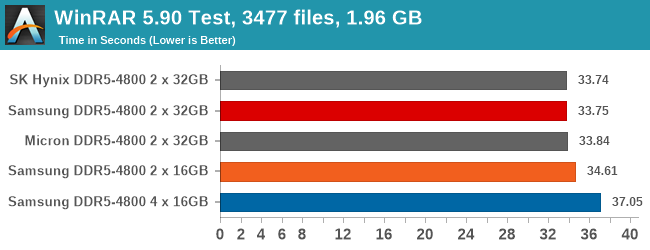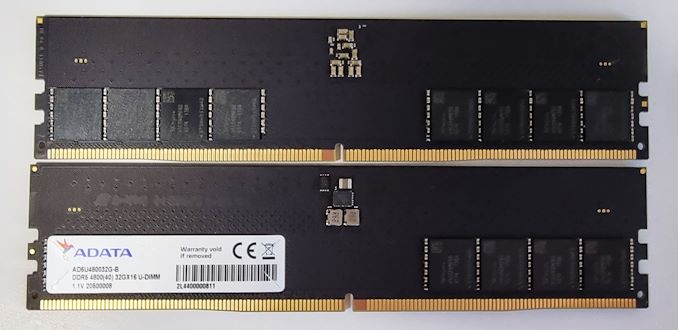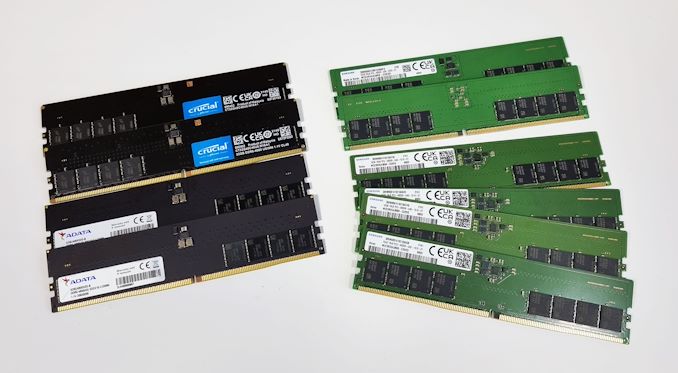DDR5 Demystified - Feat. Samsung DDR5-4800: A Look at Ranks, DPCs, and Do Manufacturers Matter?
by Gavin Bonshor on April 7, 2022 8:00 AM EST- Posted in
- Memory
- Intel
- Samsung
- Micron
- SK Hynix
- DDR5
- Alder Lake
- DDR5-4800
- 12th Gen Core
- Z690
Conclusion
When selecting a memory kit for a new system, the market is littered with many choices ranging in speed, heatsink design, RGB or no RGB, and capacity. In terms of DDR5 memory, the only platform that can utilize this at the moment is Intel's 12th Gen Core series, with its premier offerings coming in conjunction with the Z690 chipset. This is likely to change later on this year if AMD's Zen 4 architecture launches, but right now, the DDR5 market and the Alder Lake market are one in the same.
For today's article, we focused at looking at the performance differences (or lack thereof) in DDR5 in different rank and DIMM per channel configurations. While these elements are smaller factors in DDR5 performance than frequency and clockspeed, as we have found, they do have a meaningful impact on memory subsystem performance – and thus an impact on overall system performance.
Samsung DDR5-4800B: 1Rx8 (1DPC/2DPC) versus 2Rx8 (1DPC)
In testing Samsung's 2 x 32 GB (2Rx8) kit directly against a 4 x 16 GB (1Rx8) kit, we got some interesting results running at JEDEC speeds with Intel's Core i9-12900K processor.

Looking at situations where the differences were evident in benchmark results, in our WinRAR 5.90 test, which is very sensitive to memory performance and throughput, the Samsung DDR5-4800 4 x 16 GB kit performed around 9% worse than its higher density 2 x 32 GB counterpart, which is quite a drop. And even in a 1DPC configuration, the 2 x 16 GB kit with its single rank of memory does operate at a deficit versus the dual rank kits. This indicates that using 1DPC yields better performance in memory-sensitive applications than 2DPC. Meanwhile, the Samsung DDR5-4800B 2 x 32 GB configuration performed within a solid margin of error against SK Hynix and Micron kits.

It was much the same in some of our game testing, with the Samsung 4 x 16 GB kit being outperformed by the 2 x 32 GB kits, and even the Samsung 2 x 16 GB kit, which is the same single-rank UDIMMs as the 4 x 16 GB combination. While the performance hit was only around 2-3% in Grand Theft Auto V at 4K low settings, in our testing and from a performance point of view, Intel's Alder Lake seems to perform better with two sticks against four sticks of memory.
Throughout most of our testing, it was clear that in most situations, having two higher density 2Rx8 sticks in a 1DPC configuration versus the same capacity in 4 sticks (1Rx8 at 2DPC) is better for overall performance. And even looking at just 1DPC configurations, going dual-rank is still better, though to a smaller degree.
Going under the hood for an explaination for these results, the main reason that 2Rx8 is better than 1Rx8 comes down to how the integrated memory controller can only access one level of rank at a time. So in a dual rank DIMM, Rank Interleaving can be employed, which allows the second rank of memory chips to be ready for immediate access. While the differences are minimal even on a theoretical basis, as we have seen they are not zero: rank interleaving reduces response times in the pipeline refresh cycles, which can mean more performance in latency-sensitive applications, or when an application is going to be able to push DDR5 to its overall bandwidth limits.
Samsung vs SK Hynix vs Micron 32GB DDR5-4800B
Looking at the performance of the 2 x 32 GB kits running at DDR5-4800B from Samsung, SK Hynix, and Micron, the difference was for all practical purposes non-existent. We did not find any meaningful performance difference in our testing, which means that performance isn't a differentiating factor between the three memory manufacturers – at least at JEDEC settings with Alder Lake. Which, given the identical timings and capacities, is not unexpected. This is essentially the null hypothesis of our testing, showcasing that at least from a performance standpoint at fully qualified clockspeeds, there's no innate performance difference from one DRAM manufacturer to another.
Consequently, it's pretty easy here to recommend that if users are planning to build an Intel 12th Gen Core series setup with JEDEC-rated DD5 memory, they should opt for the cheapest option among proven DIMM vendors. For desktop purposes, the DIMMs are functionally equal, and right now DDR5 memory itself is still rather expensive. Although there's much more choice available in stock than there was last year, and it's still a relatively new platform, so that also adds to the cost.
Final Thoughts: 64GB of 2Rx8 with 1DPC is Better Than 64 GB of 1Rx8 with 2DPC
One of the biggest things to note from this article is that there isn't really any difference in performance between Samsung, SK Hynix, or Micron-based 2 x 32 GB DDR5-4800B memory kits. Despite using different memory ICs from each of the vendors, all these kits show that 2Rx8 DDR5 memory performs better than 1Rx8 DDR5.
The only aspect we didn't test was overclocking headroom with the JEDEC-rated kits, which wasn't really an angle we wanted base an article around. Given the lottery-like results of overclocking on any given DIMM, we'd be testing our own luck more than we'd be testing the hardware. In these cases a large sample size is required to get useful data, and that's where the dedicated memory vendors come in with their binning processes.
Taking a more meta overview on the state of the DDR5 market, we already know from vendors such as ADATA, G.Skill, and TeamGroup, that Samsung and SK Hynix's current generation parts show greater frequency and latency headroom when running above DDR5's nominal voltage of 1.1v. Which is why DDR5-6000 (and beyond) kits aren't using Micron chips. Though this may change in the future as all three companies are looking to the future with its manufacturing process, including EUV lithography.

2 x 32 GB kits of DDR5-4800B memory outperform 4 x 16 GB kits at the same frequency/latencies
As for the matter of today's tests, our results are very clear: dual-rank memory is the way to go, as is sticking to a single DIMM per channel when possible.
The most significant performance differences in our testing are found comparing two of Samsung's 1Rx8 DDR5-4800B memory sticks in a 1DPC configuration against four of the same sticks in a 2DPC configuration. There we find that the 1DPC configuration is contently equal or better in every scenario. Using four sticks means data has to travel further along the memory traces, which combined with the overhead of communicating with two DIMMs, results in both a drop in memory performance as well as a sight increase in latency.
And while the differences between 1Rx8 and 2Rx8 are not as large, we find that there is still a difference, and it's in favor of the dual rank memory. Thanks to rank interleaving, single rank memory finds itself at a slight disadvantage versus dual rank memory, at least on today's Alder Lake systems.
Based on this data, we recommend that users looking for 64 GB of DDR5 memory opt for 2 x 32 GB, rather than using a 4 x 16 GB configuration. Besides providing the best performance, the 2 x 32 GB route also leaves room for users to add additional capacity as needed down the line. Plus, if users want to overclock them further, overclocking four sticks of memory is notoriously stressful for the processor's IMC – and DDR5 only makes this worse.
Otherwise, choosing between DDR5-4800B kits from Micron, SK Hynix, and Samsung in terms of 2 x 32 GB kits primarily comes comes down to availability and price. DRAM is a true commodity product, in every sense of the word, so for these JEDEC-standard kits, there's not much to compete on except pricing.











66 Comments
View All Comments
DanNeely - Friday, April 8, 2022 - link
2DPC is much harder on the signal integrity; and only gets worse the higher the clock rate is. To the extent that several years ago there was some public speculation that DDR5 might not be able to support 2DPC at all.DanNeely - Thursday, April 7, 2022 - link
Secondary/tertiary timings generally need to be loser in 2DPC mode. The 4 dimm kit almost certainly has them set looser from the factory in XMP. Without using that (or if you combine a pair of 2 dimm kits) I'm not sure if official JDEC timings or the default BIOS behavior adjusts them down automatically or if you end up overclocking your memory trying to hold the tighter values. OTOH in the OCed timing case I'd expect it to either be about as fast as 1DPC or have stability problems (unless you're using high end modules and not taking advantage of the faster XMP settings for some reason).repoman27 - Friday, April 8, 2022 - link
AFAICT, we don't even know the primary timings here.It looks like the Crucial 2x 32GB kit was the only one in the test that had any XMP profiles. But we have no idea if the firmware defaults resulted in those being ignored, used, or possibly even used in conjunction with Intel Dynamic Memory Boost Technology. I believe Alder Lake also has System Agent Geyserville (SAGV), which is another mechanism that could potentially dynamically alter memory frequencies.
Ryan Smith - Thursday, April 7, 2022 - link
Gavin's out for the rest of the day. But once he's back in, we'll check and see if we have logs of those figures so that we can publish exactly what they were.Slash3 - Thursday, April 7, 2022 - link
That would be perfect. I suspect that the four DIMM kit was being set to looser tertiaries automatically by the BIOS, and it would be interesting to see a full ZenTimings / ASRock Timing Configurator style readout for each kit arrangement. The gap in tested bandwidth seems far too high to be a result of rank variance, even for DDR5.The Z690 compatible version of Timing Configurator can be had from the HWBot community page.
https://community.hwbot.org/topic/209738-z690-bios...
alphasquadron - Thursday, April 7, 2022 - link
I may be wrong but the Grand Theft Auto benchmark titles for 1080p and 4k may need to be reversed as it shows 4k low mode having 80 more fps higher fps 1080p max mode.tomli747 - Thursday, April 7, 2022 - link
"The R in the 1Rx8 stands for rank, so 1Rx8 means it has one rank with eight memory chips per rank. "I thought x8 means each IC correspond to 8 bit of the bus, so 1Rx16 only need 4 ICs to form a 64bit rank.
stickdisk - Thursday, April 7, 2022 - link
Please do overclocking. I understand why you don't think it proper to do so but I really want a trusted source to settle the debate between Samsung and Hynix for DDR5 OC. I have a feeling they are actually the same but the OC community has fallen for the idea that Hynix is better.Also please look into clearing up whether higher XMP kits are just price segmentation tactic for memory vendors to make more money or are actually better binned. I'm sure they are better binned at times but I am also fairly confident they charge more for what is just a kit with an OC and not a better bin. This information could help people save some money.
Getting information of memory IC differences being the biggest indicator of potential memory performance into the mainstream is invaluable. This is important because I see way to many people building $2000+ PCs worrying about CPU OC for up to 5% more performance and not worrying about RAM OC for up to 10% more performance. Mainstream people don't have their priorities straight because mainstream tech influencers don't know better.
Oxford Guy - Thursday, April 7, 2022 - link
The benefit of XMP is that ordinary people don't have to try to do manual RAM overclocking, which is too complicated to be worthwhile for most people — especially on less-expensive boards that simply refuse to post and require guesses and manual CMOS clearing with a screwdriver. If one has the luxury of a fancy board with highly-specific post codes on a display, a CMOS reset button on the back panel (and, optimally, the ability to simply switch to a different profile), and reliable bypass of unstable RAM settings automatically by the board (preventing no-post situations) it might be worth doing for some enthusiasts. I suppose some of the new software configuration programs help to reduce the pain of RAM tinkering. I would rather switch on XMP and that's that, particularly when the RAM vendor promises it will work with the board I'm using at that speed.Oxford Guy - Thursday, April 7, 2022 - link
With DDR4 there is a difference between a daisy chain layout and a T topology layout, in terms of which layout is optimal with 2 sticks of RAM (daisy) and which is optimal with 4 (T). Does that model continue with DDR5? Which layout does this MSI board use and have you tried the other layout to verify that the board layout is not a factor?